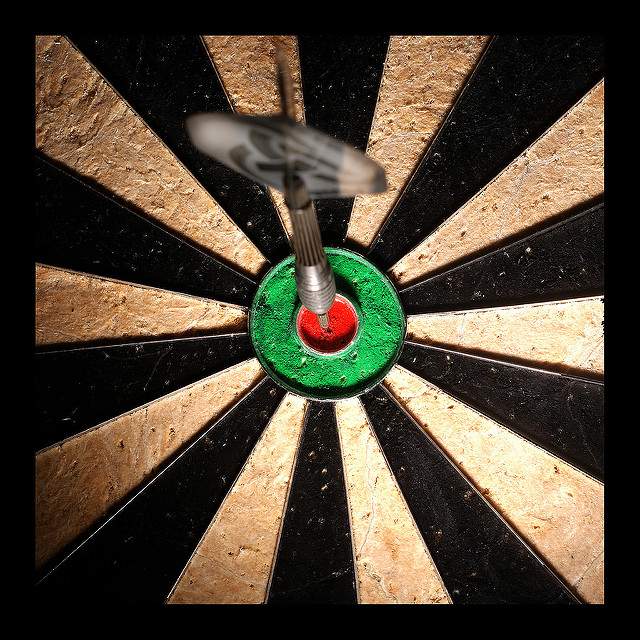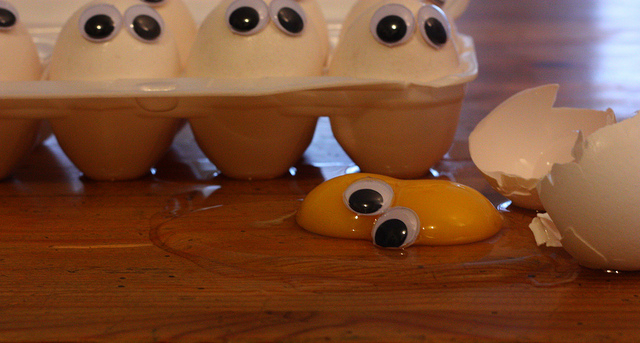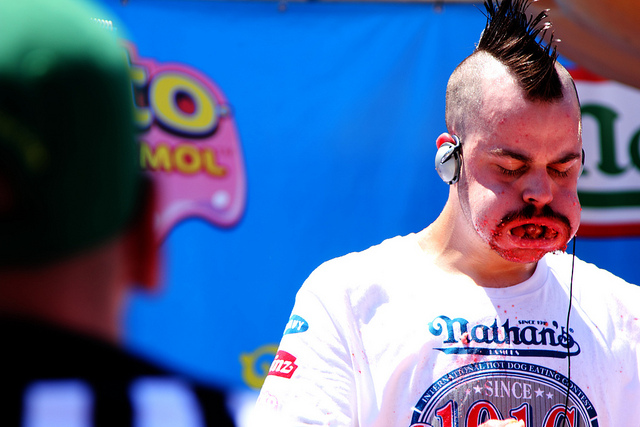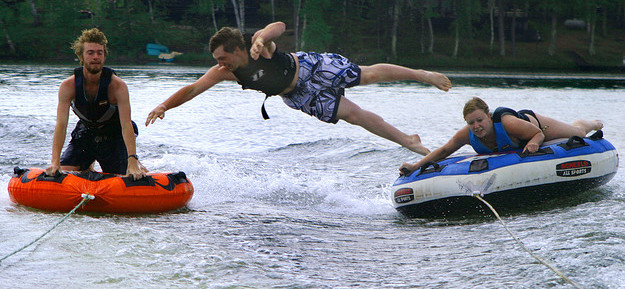Posts Tagged ‘Competitiveness’
Imagination
 If you can’t imagine it, it can’t be done.
If you can’t imagine it, it can’t be done.
But if it can’t be done, how can you imagine it?
No one is buying a product like the one you imagined. There’s no market.
No one can buy an imaginative product that doesn’t yet exist. There may be a market.
Imagine things are good, just as they are.
Imagine an upstart competitor will obsolete your best product.
Let’s fix what is.
Let’s imagine what isn’t, and build it.
Don’t waste time imagining radical new concepts. There’s no way to get there.
Use your imagination to create an unobtainable concept, then build a bridge to get there.
Imagine the future profits of our great recipe. Let’s replicate it.
Imagine our recipe has a half-life. Let’s disrupt it.
To be competitive, we’ve got to use our imagination to reduce the cost of our products.
To be competitive, we’ve got to use our imagination to obsolete our best work.
Put together a specification, a detailed Gannt chart and make it happen on time.
Imagine what could be, and make a prototype.
Let’s shore up our weaknesses and live to fight another day.
Let’s imagine our strength as a weakness and invent the future.
We are the best in the industry. Imagine how tough it is to be our competitor.
Imagine there’s a hungry start-up who will do whatever it takes to get the business.
We’ve got to protect our market share.
Imagine what we could create if we weren’t constrained by our success.
Imagine how productive we will be when we standardize the work.
Imagine how much fun we will have when we reinvent the industry.
Ask the customer what they want, built it and launch it.
Imagine what could be, build a prototype, show the customer, listen and refine.
Let’s follow the script. Imagine the profits.
Let’s burn the script and imagine a new one.
Image credit — Allegra Ricci
Understanding the trajectory of the competitive landscape
 If you want to gain ground on your competition you’ve first got to know where things stand. Where are their advantages? Where are your advantages? Where is there parity? To quickly understand the situations there are three tricks: stay at a high level, represent the situation in a clear way and, where possible, use public information from their website.
If you want to gain ground on your competition you’ve first got to know where things stand. Where are their advantages? Where are your advantages? Where is there parity? To quickly understand the situations there are three tricks: stay at a high level, represent the situation in a clear way and, where possible, use public information from their website.
A side-by-side comparison of the two companies’ products is the way to start. Create a common set of axes with price running south to north and performance (or output) running west to east. Make two copies and position them side-by-side on the page – yours on the left and theirs directly opposite on the right. Go to their website (and yours) and make a list of every product, its price and its output. (For prices of their products you may have to engage your sales team and your customers.) For each of your products place a symbol (the company logo) on your performance-price landscape and do the same for their products on their landscape. It’s now clear who has the most products, where their portfolio outflanks yours and where you outflank them. The clarity and simplicity will help everyone see things as they are – there may be angst but there will be no confusion and no disagreement. The picture is clear. But it’s static.
The areal differences define the gaps to close and the advantages to exploit. Now it’s time to define the momentum and trajectories of the portfolios to add a dynamic element. For your most recent product launch add a one next to its logo, for the second most recent add a two and for the third add three. These three regions of your portfolio are your most recent focus areas. This is your trajectory and this is where you have momentum. Extend and arrow in the direction of your trajectory. If you stay the course, this is where your portfolio will add mass. Do the same for your competitor and compare arrows. You know have a glimpse into the future. Are your arrows pointing in the same directions as theirs? Are they located in the same regions? How would feel if both companies continued on their trajectories? With this addition you have glimpse into the stay-the-course future. But will they stay the course? For that you need to look at the patent landscape.
Do a patent search on their patents and applications over the previous year and represent each with its most descriptive figure. Write a short thematic description for each, group like themes and draw a circle around them. Mark the circle with a one to denote last year’s patents. Repeat the process for two years ago and three years ago and mark each circle accordingly. Now you have objective evidence of the future. You know where they have been working and you know where they want to go. You have more than a glimpse into the future. You know their preferred trajectories. Reconcile their preferred trajectories with their price-performance landscapes and arrows 1, 2 and 3. If their preferred trajectories line up with their product momentum, it’s business as usual for them. If they contradict, they are playing a different game. And because it takes several years for patent applications to publish, they’ve been playing a new game for a while now.
Repeat the process for your patent landscape and flop it onto your performance-price landscape. I’m not sure what you’ll see, but you’ll know it when you see it. Then, compare yours with theirs and you’ll know what the competitive landscape will look like in three years. You may like what you see, or not. But, the picture will be clear. There may be discomfort, but there can be no arguments.
This process can also be used in the acquisition process to get a clear picture a company’s future state. In that way you can get a calibrated view three years into the future and use your crystal ball to adjust your offer price accordingly.
Image credit – Rob Ellis
Connection Before Numbers
 Compound annual growth, profit margin, Key Business Indicators, capability indices, defects per million opportunity, confidence intervals, statistical significance, regression coefficients, temperature, pressure, force, stress, velocity, volume, inches, meters, decibels. The numbers are supposed to tell the story. But they don’t.
Compound annual growth, profit margin, Key Business Indicators, capability indices, defects per million opportunity, confidence intervals, statistical significance, regression coefficients, temperature, pressure, force, stress, velocity, volume, inches, meters, decibels. The numbers are supposed to tell the story. But they don’t.
There’s never enough data to see the whole picture. But, even when the discussion is limited to topics covered by the data, people don’t see things the same way. And even if the numbers were 100% complete, there would be no common interpretation. And if there was a common interpretation there’d be a range of diverging opinions on how to move forward. Even with perfect numbers, there is divergence among people.
Numbers are numb. They don’t have meaning until we attach it. And, as entities that attach meaning, we think do it rationally. But we use past history and fear to assign meaning. We are not rational, we’re emotional. Even the most rigorous scientist has an obsessive nature, infatuation and deep fascination. Even when swimming in a sea of data, we’re emotional, and, therefor, irrational.
Excitement, happiness, joy, anxiety, sadness, fear, collaboration, cooperation, competition, respect, disrespect, kindness, love. We live and work in a collection of people systems where emotion carries the day. Emotion and irrationality are not bad, it’s the way it is. We’re human. And, I’m thankful for it.
But with emotion and irrationality comes connection as part of the matched set. If you want one, you have to buy all three. And I want connection. Connection brings out the best in people – their passion, energy and love. When magical things happen at work, connection is responsible. And when magic happens at home, it’s connection.
I’m thankful I have strong connections.
Image credit – Irudayam
Where there’s fun there is no fear.
 For those who lead projects and people, failure is always lurking in the background. And gone unchecked, it can hobble. Despite best efforts to put a shine on it, there’s still a strong negative element to failure. No two ways about it, failure is mapped with inadequacy and error. Failure is seen as the natural consequence of making a big mistake. And there’s a finality to failure. Sometimes it’s the end of a project and sometimes it’s the end of a career. Failure severely limits personal growth and new behavior. But at least failure is visible to the naked eye. There’s no denying a good train wreck.
For those who lead projects and people, failure is always lurking in the background. And gone unchecked, it can hobble. Despite best efforts to put a shine on it, there’s still a strong negative element to failure. No two ways about it, failure is mapped with inadequacy and error. Failure is seen as the natural consequence of making a big mistake. And there’s a finality to failure. Sometimes it’s the end of a project and sometimes it’s the end of a career. Failure severely limits personal growth and new behavior. But at least failure is visible to the naked eye. There’s no denying a good train wreck.
A fumble is not failure. When something gets dropped or when a task doesn’t get done, that’s a fumble. A fumble is not catastrophic and sometimes not even noteworthy. A fumble is mapped with a careless mistake that normally doesn’t happen. No real cause. It just happens. But it can be a leading indicator of bigger and badder things to come, and if you’re not looking closely, the fumble can go unnoticed. And the causes and conditions behind the fumble are usually unclear or unknown. Where failure is dangerous because everyone knows when it happens, fumbles are dangerous because they can go unnoticed.
Floundering is not fumbling. With floundering, nothing really happens. No real setbacks, no real progress, no real energy. A project that flounders is a project that never reaches the finish line and never makes it to the cemetery. To recognize floundering takes a lot of experience and good judgment because it doesn’t look like much. But that’s the point – not much is happening. No wind in the sails and no storm on the horizon. And to call it by name takes courage because there are no signs of danger. Yet it’s dangerous for that very reason. Floundering can consume more resources than failure.
Fear is the fundamental behind failing, fumbling and floundering. But unlike failure, no one talks about fear. Talking about fear is too scary. And like fumbling and floundering, fear is invisible, especially if you’re not looking. Like diabetes, fear is a silent killer. And where diabetes touches many, fear gets us all. Fear is invisible, powerful and prolific. It’s a tall order to battle the invisible.
But where there’s fun there can be no fear. More precisely, there can be no negative consequence of fear. When there’s fun, everyone races around like their hair is on fire. Not on fire in the burn unit way, but on fire in the energy to burn way. When there’s fun people help each other for no reason. They share, they communicate and they take risks. When there’s fun no one asks for permission and the work gets done. When there’s fun everyone goes home on time and their spouses are happy. Fun is easy to see, but it’s not often seen because it’s rare.
If there’s one thing that can go toe-to-toe with fear, it’s fun. It’s that powerful. Fun is so powerful it can turn failure into learning. But if it’s so powerful, why don’t we teach people to have fun? Why don’t we create the causes and conditions so fun erupts?
I don’t know why we don’t promote fun. But, I do know fun is productive and fun is good for business. But more important than that, fun is a lot of fun.
Image credit – JoshShculz
Business Models Are Finite
 Like it or not, everything changes. The rock solid brand will erode and the venerable business model will wither and die. Though you will add immense energy to hold on to what you built, natural forces of competitive evolution will come up with something makes your best work extinct.
Like it or not, everything changes. The rock solid brand will erode and the venerable business model will wither and die. Though you will add immense energy to hold on to what you built, natural forces of competitive evolution will come up with something makes your best work extinct.
We see it in our everyday lives. Houses need new roofs, cars needs new tires and our kids grow out of their best clothes. Sure we do everything we can to make things last, but we know that ultimately the roof will collapse and the tires will blow out. It doesn’t matter if we don’t want it to happen. It will happen without our consent. And we can see it coming. The roof loses some shingles, some tar paper shows through in spots and we know the leaks will follow. The leaks are not wanted, but they’re not a surprise. And it’s the same with tires. They start to rumble at highway speed, they get you stuck in snow that wasn’t a problem last year and the hydroplaning is inevitable. It’s not if it’s when. You rotate them, you keep them inflated and you know they will give it up. If you’re surprised it’s because you didn’t pay attention.
But in business we deny our business models have a natural life span and we deny what worked last year will not always work next year. And like with tires the signs of wear are obvious, but we dismiss the bumpy ride and the loss of traction in the market. And when the tar paper is clearly showing through the business model and someone points it out they are ignored or even ostracized for calling attention to the deep problem. And that’s the thing – it’s too deep to acknowledge, too deep to talk about. It’s too uncertain and therefore too frightening. The fear of a dwindling reality is stronger than the fear of doing something new so we put plywood over the windows and try to ride out the storm that will only get stronger.
Plywood is good when the radar says the hurricane will last for three hours. But plywood isn’t going to cut it when the fifth hurricane in a month picks up the house and blows it into the next county. The decision to evacuate the business model and abandon what worked is a tough one. It’s emotionally charged. There are pictures on the wall of four generation of CEOs and there are memories of successful production launches and an unnamable feeling of comfort in everything, including the bad cafeteria food you grew up on.
To ignore the natural forces of change is unskillful. It’s not good for the stock price but more importantly it’s not good for your personal wellbeing. It’s emotionally draining to bury the truth from yourself and it’s an immense waste of resources to continually prop up something that should be evacuated.
It’s not safer to bury your head in the sand. Call attention to the leaky roof and point out that people aren’t supposed to need to add air to leaky tires every other day. And when they dismiss you, don’t accept it. No one can dismiss you without your consent. Don’t give it to them.
Image credit – Don McCullough
Rule 1: Don’t start a project until you finish one.
 One of the biggest mistakes I know is to get too little done by trying to do too much.
One of the biggest mistakes I know is to get too little done by trying to do too much.
In high school we got too comfortable with partial credit. Start the problem the right way, make a few little mistakes and don’t actually finish the problem – 50% credit. With product development, and other real life projects, there’s no partial credit. A project that’s 90% done is worth nothing. All the expense with none of the benefit. Don’t launch, don’t sell. No finish, no credit.
But our ill-informed focus on productivity has hobbled us. Because we think running projects in parallel is highly efficient, we start too many projects. This glut does nothing more than slow down all the other projects in the pipeline. It’s like we think queuing theory isn’t real because we don’t understand it. But to be fair to queuing and our stockholders, queuing theory is real.
Queues are nothing more than a collection of wayward travelers waiting in line for a shared resource. Wait in line for fast food, you’re part of a queue. Wait in line for a bank teller (a resource,) you’re queued up. Wait in line to board a plane, you’re waiting in a queue. But the name isn’t important. Line or queue, what matters is how long you wait.
Lines are queues and queues are lines, but the math behind them is funky. From firsthand experience we know longer queues mean longer wait times. And if the cashier isn’t all that busy (in queuing language – the utilization of the resource is low) the wait time isn’t all that bad and it increases linearly with the number of people (or jobs) in the queue. When the shared resource (cashier) isn’t highly utilized (not all that busy), add a few more shoppers per hour and wait times increase proportionately. But, and this is a big but, if the resource busy more than 80% of the time, increasing the number of shoppers increases the wait time astronomically (or exponentially.) When shoppers arrive in front of the cashier just a bit more often, wait times can double or triple or more.
For wait times, the math of queueing theory says one plus one equals two and one plus one plus one equals seven. Wait times increase linearly right up until they explode. And when wait times explode, projects screech to a halt. And because there’s no partial credit, it’s a parking lot of projects without any of the profit. And what’s the worst thing to do when projects aren’t finishing quickly enough? Start more projects. And what do we do when projects aren’t launching quickly enough? Start more projects.
When there’s no partial credit, instead of efficiency it’s better to focus on effectiveness. Instead of counting the number of projects running in parallel (efficiency,) count the number of projects that have finished (effectiveness.) To keep wait times reasonable, fiercely limit the amount of projects in the system. And there’s a simple way to do that. Figure out the sweet spot for your system, say, three projects in parallel, and create three project “tickets.” Give one ticket to the three active projects and when the project finishes, the project ticket gets assigned to the next project so it can start. No project can start without a ticket. No ticket, no project.
This simple ticket system caps the projects, or work in process (WIP,) so shared resources are utilized below 80% and wait times are low. Projects will sprint through their milestones and finish faster than ever.
By starting fewer projects you’ll finish more. Stop starting and start finishing.
Image credit – Fred Moore
When doing new work, you’ll be wrong.
 When doing something from the first time you’re going to get it wrong. There’s no shame in that because that’s how it goes with new work. But more strongly, if you don’t get it wrong you’re not trying hard enough. And more strongly, embrace the inherent wrongness as a guiding principle.
When doing something from the first time you’re going to get it wrong. There’s no shame in that because that’s how it goes with new work. But more strongly, if you don’t get it wrong you’re not trying hard enough. And more strongly, embrace the inherent wrongness as a guiding principle.
Take Small Bites. With new work, a small scope is better than a large one. But it’s exciting to do new work and there’s a desire to deliver as much novel usefulness as possible. And, without realizing it, the excitement can lead to a project bloated with novelty. With the best intentions, the project team is underwater with too much work and too little time. With new work, it’s better to take one bite and swallow than three and choke.
Ratchet Thinking. With new work comes passion and energy. And though the twins can be helpful and fun to have around, they’re not always well-behaved. Passion can push a project forward but can also push it off a cliff. Energy creates pace and can quickly accelerate a project though the milestones, but energy can be careless and can just as easily accelerate a project in the wrong direction. And that’s where ratchet thinking can help.
As an approach, the objective of ratchet thinking is to create small movements in the right direction without the possibility of back-sliding. Solve a problem and click forward one notch; solve a second problem and click forward another notch. But, with ratchet thinking, if the third problem isn’t solved, the project holds its ground at the second notch. It takes a bit more time to choose the right problem and to solve it in a way that cannot unwind progress, but ultimately it’s faster. Ratchet thinking takes the right small bite, chews, swallows.
Zero Cost of Change. New work is all about adding new functions, enhancing features and fixing what’s broken. In other words, new work is all about change. And the faster change can happen, the faster the product/service/business model is ready for sale. But as the cost of change increases the rate of changes slows. So why not design the project to eliminate the cost of change?
To do that, design the hardware with a bit more capability and headroom so there’s some wiggle room to handle the changes that will come. Use a modular approach for the software to minimize the interactions of software changes and make sure the software can be updated remotely without customer involvement. And put in place a good revision control (and tracking) mechanism.
Doing new work is full of contradictions: move quickly, but take the time to think things through; take on as much as you can, but no more; be wrong, but in the right way; and sometimes slower is faster.
But doing new work you must.
image credit – leasqueaky
What Innovation Feels Like
 There are countless books and articles on innovation. You can read how others have done it, what worked and what didn’t, how best to organize the company and how to define it. But I have not read much about how it feels to do innovation.
There are countless books and articles on innovation. You can read how others have done it, what worked and what didn’t, how best to organize the company and how to define it. But I have not read much about how it feels to do innovation.
Before anything meaningful can happen, there must be discontent or anger. And for that there needs to be a realization that doing things like last time is a bad idea. This realization is the natural outcome of looking deeply at how things really are and testing the assumptions of the status quo. And the best way to set all this in motion is to do things that generate immense boredom.
Boredom can be created in two ways. 1. Doing the same boring work in the same boring way. 2. Stopping all activity for 30 minutes a day and swimming in the sea of your boring thoughts. Both work well, but the second one works faster.
Next, with your discontent in hand, it’s time birth the right question. Some think this the time for answers, but with innovation the real work is to figure out the question. The discomfort of trying to discover the right question is seven times more uncomfortable the discomfort of figuring out the right answer. And once you have the right question, the organization rejects you as a heretic. If the organization doesn’t dismiss you in a visceral way, you know you don’t have the right question. You will feel afraid, but repeat the cycle until your question threatens the very thing that has made the company successful. When people treat you like you threaten them, you know you’re on to something.
To answer your question, you need help from the organization, but the organization withholds them from you. If you are ignored, blocked or discredited, you’re on the right path. Break the rules, disregard best practices, and partner with an old friend who trusts you. Together, rally against the organization and do the work to answer your question. If you feel isolated, keep going. You will feel afraid and you will second guess yourself. Proceed to the next step.
Make a prototype that shows the organization that your question has an answer. Don’t ask, just build. Show the prototype to three people and prepare for rejection. You and your prototype will be misunderstood and devalued. Not to worry, as this is a good sign. Revise the prototype and repeat.
Do anything you can to show the prototype to a customer. Video the customer as they interact with the prototype. You will feel afraid because you are breaking the rules. This is how you should feel. Keep going.
Set up a meeting with a leader who can allocate resources. If you have to, set up the meeting under false pretenses (the organization is still in rejection mode) and show the video. Because of the uncertainty of their response, you will feel afraid. Show the video anyway.
The organization is comfortable working in the domains of certainty and control, but innovation is done in the domain of uncertainty. By definition, the organization will reject your novel work. If you are rejected, keep going. Revise your heretical question, build a prototype to answer it, show a customer, show someone who can allocate resources, and be afraid all along the way. And repeat, as needed.
With innovation, mostly you feel afraid.
Image credit – Tybo
Creating a brand that lasts.
 One of the best ways to improve your brand is to improve your products. The most common way is to provide more goodness for less cost – think miles per gallon. Usually it’s a straightforward battle between market leaders, where one claims quantifiable benefit over the other – Ours gets 40 mpg and theirs doesn’t. And the numbers are tied to fully defined test protocols and testing agencies to bolster credibility. Here’s the data. Buy ours
One of the best ways to improve your brand is to improve your products. The most common way is to provide more goodness for less cost – think miles per gallon. Usually it’s a straightforward battle between market leaders, where one claims quantifiable benefit over the other – Ours gets 40 mpg and theirs doesn’t. And the numbers are tied to fully defined test protocols and testing agencies to bolster credibility. Here’s the data. Buy ours
But there’s a more powerful way to improve your brand, and that’s to map your products to reliability. It’s far a more difficult game than the quantified head-to-head comparison of fuel economy and it’s a longer play, but done right, it’s a lasting play that is difficult to beat. Run the thought experiment: think about the brands you associate with reliability. The brands that come to mind are strong, lasting brands, brands with staying power, brands whose products you want to buy, brands you don’t want to compete against. When you buy their products you know what you’re going to get. Your friends tell you stories about their products.
There’s a complete a complete tool set to create products that map to reliability, and they work. But to work them, the commercialization team has to have the right mindset. The team must have the patience to formally define how all the systems work and how they interact. (Sounds easy, but it can be painfully time consuming and the level of detail is excruciatingly extreme.) And they have to be willing to work through the discomfort or developing a common understanding how things actually work. (Sounds like this shouldn’t be an issue, but it is – at the start, everyone has a different idea on how the system works.) But more importantly, they’ve got to get over the natural tendency to blame the customer for using the product incorrectly and learn to design for unintended use.
The team has got to embrace the idea that the product must be designed for use in unpredictable ways in uncontrolled conditions. Where most teams want to narrow the inputs, this team designs for a wider range of inputs. Where it’s natural to tighten the inputs, this team designs the product to handle a broader set of inputs. Instead of assuming everything will work as intended, the team must assume things won’t work as intended (if at all) and redesign the product so it’s insensitive to things not going as planned. It’s strange, but the team has to design for hypothetical situations and potential problems. And more strangely, it’s not enough to design for potential problems the team knows about, they’ve got to design for potential problems they don’t know about. (That’s not a typo. The team must design for failure modes it doesn’t know about.)
How does a team design for failure modes it doesn’t know about? They build a computer-based behavioral model of the system, right down to the nuts, bolts and washers, and they create inputs that represent the environment around the system. They define what each element does and how it connects to the others in the system, capturing the governing physics and propagation paths of connections. Then they purposefully break the functions using various classes of failure types, run the analysis and review the potential causes. Or, in the reverse direction, the team perturbs the system’s elements with inputs and, as the inputs ripple through the design, they find previously unknown undesirable (harmful) functions.
Purposefully breaking the functions in known ways creates previously unknown potential failure causes. The physics-based characterization and the interconnection (interaction) of the system elements generate unpredicted potential failure causes that can be eliminated through design. In that way, the software model helps find potential failures the team did not know about. And, purposefully changing inputs to the system, again through the physics and interconnection of the elements, generates previously unknown harmful functions that can be designed out of the product.
If you care about the long-term staying power of your brand, you may want to take a look at TechScan, the software tool that makes all this possible.
Image credit — Chris Ford.
Growth for growth’s sake isn’t the answer
 Growth, as a strategy, is flawed. Draw a control volume around the planet and accelerate the growth engines: the natural conclusion – we run out of natural resources. Not if, when. Anything with a finite end condition is finite. That’s a rule. Because the world has finite resources, growth is finite.
Growth, as a strategy, is flawed. Draw a control volume around the planet and accelerate the growth engines: the natural conclusion – we run out of natural resources. Not if, when. Anything with a finite end condition is finite. That’s a rule. Because the world has finite resources, growth is finite.
Economists say growth is the only way. And the analysts say you’ve got to grow faster than their expectations or they’ll penalize your stock price. Economists say growth must be eternal and analysists say it’s never fast enough. The treadmill of growth keeps us accelerating, and we’re moving too fast to stop and ask why.
The idea behind growth is simple – with growth comes riches. As we’ve defined the system, when companies grow the people that own stock make more money. And in with our consumption mindset, more money means more stuff. Cutting right to it, company growth breeds bank account growth, which in turn breeds four cars, a 5,000 square foot primary residence, two vacation homes, closets full of too many clothes, three iPads, six laptops and five smart phones. And from this baseline, continued growth breeds more spiraling consumption.
If the consumption was curbed, what would happen to the riches?
Growth is better when it’s a result. Solve a societal problem and growth results, but instead of just filling the coffers, peoples’ lives get better. Make the water cleaner, people get healthier and you grow. And because you see the societal benefit, you feel better about yourself and your work.
Stock price increases when analysts think growth will increase. And increased stock price creates more wealth to fund more growth and fund more consumption. And, more consumption creates the right conditions for more growth.
What would happen if there was no growth?
If we were content with what we have, flat sales wouldn’t be a problem because we’d not need to consume more. And if we didn’t need to consume more we’d be happy with the money we make. No growth would be no problem.
Today, increased productivity is used to support increased sales. The incremental capacity (more units per hour) provides more products so more can be sold which creates growth. But in a “no growth” universe where growth is prohibited, instead of selling more, people would work less. Increase productivity by 25% and instead of working five days a week, everyone works four. That’s hard to imagine, but the numbers work. Instead of more money, we’d have more time.
Money isn’t finite, but time is. If we can learn to see time as something more valuable than money, maybe things can turn around. If we can see a growth in leisure time as some twisted form of consumption, maybe that would make it okay to spend more time doing the things we want to do.
Image credit — Michael
Put your success behind you.
The biggest blocker of company growth is your successful business model. And the more significant it’s historical success, the more it blocks.
Novelty meaningful to the customer is the life force of company growth. The easiest novelty to understand is novelty of product function. In a no-to-yes way, the old product couldn’t do it, but the new one can. And the amount of seconds it takes for the customer to notice (and in the case of meaningful novelty, appreciate) the novelty is in an indication of its significance. If it takes three months of using the product, rigorous data collection and a t-test, that’s not good. If the customer turns on the product and the novelty smashes him in the forehead like a sledgehammer, well, that’s better.
It’s difficult to create a product with meaningful novelty. Engineers know what they know, marketers know what they market, and the salesforce knows how to sell what they sell. And novelty cuts across their comfort. The technology is slightly different, the marketing message diverges a bit, and the sales argument must be modified. The novelty is driven by the product and the people respond accordingly. And, the new product builds on the old one so there’s familiarity.
Where injecting novelty into the product is a challenge, rubbing novelty on the business model provokes a level 5 pucker. Nothing has the stopping power of a proposed change to the business model. Novelty in the product is to novelty in the business model as lightning is to lightning bug – they share a word, but that’s it.
Novelty in the product is novelty of sheet metal, printed circuit boards and software. Novelty in the business model is novelty in how people do their work and novelty in personal relationships. Novelty in the product banal, novelty in the business model is personal.
No tools or best practices can loosen the pucker generated by novelty in the business model. The tired business model has been the backplane of success for longer than anyone can remember. The long-in-the-tooth model has worn deep ruts of success into the organization. Even the all-powerful Lean Startup methodology can’t save you.
The healing must start with an open discussion about the impermanence of all things, including the business model. The most enduring radioactive element has a half-life, and so does the venerable business model, even the most successful.
Where novelty in the product is technical, novelty in the business model is emotional. And that’s what makes it so powerful. Sprinkling the business model with novelty is scary at a deeply personal level – career jeopardy, mortgage insecurity and family volatility are primal drivers. But if you can push through, the rewards are magical.
Your business model has shaped you into an organization that’s optimized to do what it does. You can’t create new markets and sell to new products to new customers without changing your business model. Your business model may have been your secret sauce, but the world’s tastes have changed. It’s time to put your success behind you.
Image credit — MandaRose

 Mike Shipulski
Mike Shipulski